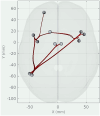Effect of Repetitive Transcranial Magnetic Stimulation on the Symptoms and Brain Imaging in Patients with Fibromyalgia Syndrome: A Randomized Controlled Pilot Trial
- PMID: 40884738
- PMCID: PMC12484483
- DOI: 10.1007/s40122-025-00770-2
Effect of Repetitive Transcranial Magnetic Stimulation on the Symptoms and Brain Imaging in Patients with Fibromyalgia Syndrome: A Randomized Controlled Pilot Trial
Abstract
Introduction: Repetitive transcranial magnetic stimulation (rTMS) of the left dorsolateral prefrontal cortex (DLPFC) has been shown to reduce the symptoms of patients with fibromyalgia syndrome (FMS). We tested whether rTMS of the left DLPFC can reduce the main symptoms in FMS and whether TMS induces changes in brain functional and structural connectivity, cortical gray matter volume, and the metabolites/neurotransmitters GABA and combined glutamate/glutamine (Glx).
Methods: Twenty-seven women diagnosed with FMS according to the 2010 ACR criteria were included in a randomized controlled trial. They received either ten sessions of active or sham 10-Hz stimulation over 2 weeks embedded in a longitudinal neuroimaging setup, including one pre-treatment (T1), one post-treatment (T2), and one follow-up (T3) 3 T MRI scan. Pain and pain catastrophizing, depression, daily life/quality of life, and anxiety were assessed using standard questionnaires.
Results: Linear mixed-model analysis of clinical data showed a significant main effect of the main factor time but did not reveal group differences or group-time interactions, indicating a large placebo effect with symptom reduction in both groups. Fractional anisotropy (FA) values of the pontine crossing tract, the sagittal stratum, and the right cingulum in the active rTMS group increased between pre-TMS and the follow-up time points. Subgroup analysis of responders of the treatment group revealed higher functional connectivity between the left DLPFC and the right cerebellum. We did not find evidence for changes in the treatment group in the gray matter of the left DLPFC and for the concentrations of GABA and Glx, but a trend towards decreasing Glx levels for the factor time in all patients could be detected.
Conclusions: While these results may be due to small sample size and short treatment duration, the findings of increased FA after active rTMS and higher functional connectivity between DLPFC and cerebellum in responders should be further explored.
Trial registration: Auswirkungen der nicht-invasiven Neuromodulation auf das Gehirn bei Fibromyalgiepatienten.
Drks-id: DRKS00019051.
Keywords: Brain imaging; Diffusion tensor imaging; Dorsolateral prefrontal cortex; Fibromyalgia syndrome; Gray matter volume; HF-rTMS; Neuromodulation; Pain; Proton MR spectroscopy; Resting-state functional MRI.
© 2025. The Author(s).
Conflict of interest statement
Declarations. Conflict of Interest: Laura Ackermann, Daniel Zeller, Thorsten Odorfer, György A. Homola, Thomas Kampf, Mirko Pham, Hans-Christoph Aster and Claudia Sommer have no conflict of interest to declare. Thorsten Odorfer has consulted for TEVA. Daniel Zeller has consulted for Novartis and has been on the Advisory board of Biogen. He has given a talk for Angelini Pharma and received travel compensation. Claudia Sommer has given educational talks for Alnylam, argenx, CSL Behring, Grifols, GSK, Kedrion, Novartis, Pfizer, Takeda, TEVA. She has consulted for Akigai, Algiax, Annexon, argenx, Bayer, CSL-Behring, Grifols, Kedrion, Nevro, Sanofi, Takeda, TEVA. Claudia Sommer is an Editorial Board member of Pain and Therapy and deputy editor of the European Journal of Neurology. She was not involved in the selection of peer reviewers for the manuscript nor any of the subsequent editorial decisions. Laura Ackermann, György A. Homola, Thomas Kampf, Mirko Pham and Hans-Christoph Aster have nothing to disclose. Laura Ackermann changed her affiliation during the completion of the manuscript to the Department of Oto-Rhino-Laryngology, Head and Neck Surgery of the University Hospital Würzburg. Ethical Approval: All patients gave written informed consent to the study according to the Declaration of Helsinki. The Ethics Committee of the University of Würzburg Medical Faculty approved the study (140/19).
Figures





References
-
- Eich W, Bär KJ, Bernateck M, et al. Definition, classification, clinical diagnosis and prognosis of fibromyalgia syndrome: Updated guidelines 2017 and overview of systematic review articles. Schmerz. 2017;31(3):231–8. - PubMed
-
- Clauw DJ. Fibromyalgia: a clinical review. J Am Med Assoc. 2014;311(15):1547–55. - PubMed
-
- Häuser W, Ablin J, Fitzcharles MA, et al. Fibromyalgia. Nat Rev Dis Primers. 2015;1: 15022. - PubMed
-
- Üçeyler N, Burgmer M, Friedel E, et al. Etiology and pathophysiology of fibromyalgia syndrome: Updated guidelines 2017, overview of systematic review articles and overview of studies on small fiber neuropathy in FMS subgroups. Schmerz. 2017;31(3):239–45. - PubMed
-
- Sommer C, Häuser W, Alten R, et al. Drug therapy of fibromyalgia syndrome. Systematic review, meta-analysis and guideline. Schmerz. 2012;26(3):297–310. - PubMed
LinkOut - more resources
Full Text Sources
Research Materials
Miscellaneous

